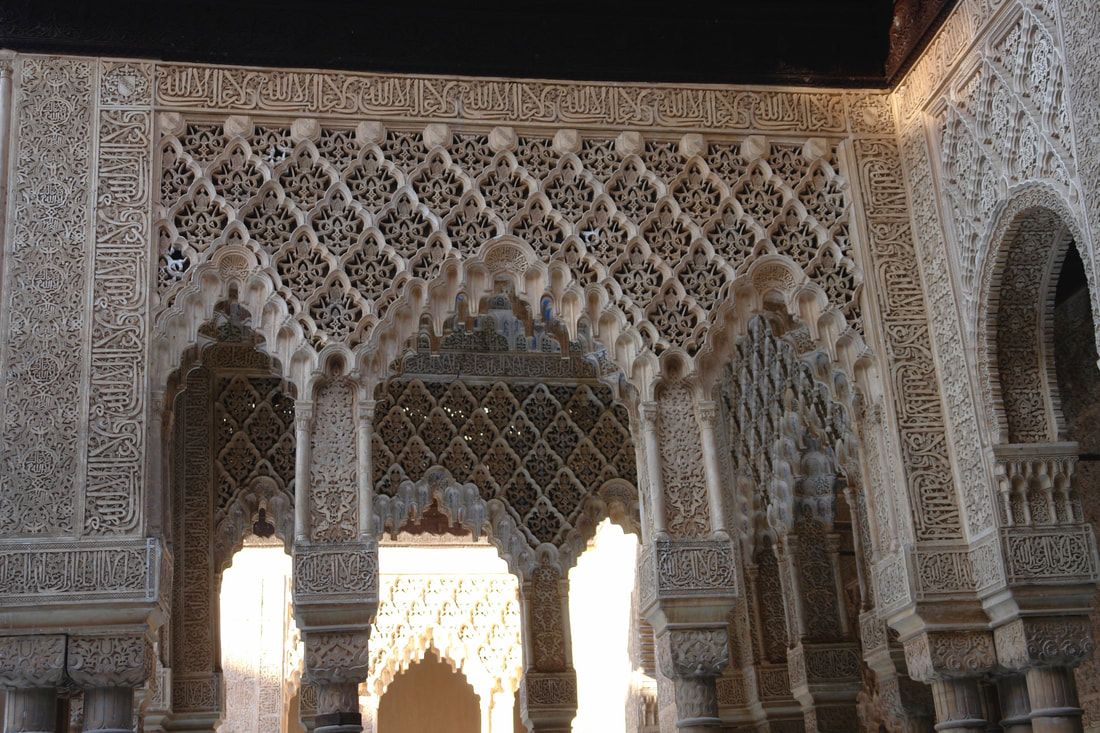Those of you who have visited the Great Mosque in Córdoba, the ruins of Madinat al-Zahra or the Alhambra in Granada cannot fail to have been impressed by the beautiful carvings that still remain – some in their entirety and others as fragments. The men who created these beautiful monuments were mostly local artisans, but there were also artists from Baghdad and Damascus who had brought the skills to al-Andalus and both taught the local men and worked alongside them.

To achieve these magnificent results, the interior walls of the buildings were coated with a layer of stucco – a thin plaster coating that could be moulded or carved into decorative designs. The wall was first covered with the coating of plaster and then the design was marked out on its surface and incised by hand. Sometimes the design was made in moulded sections which were then applied to the wall once they were ready. This ceiling looks as though it was made in this way. The patterns they used were invariably geometric and floral, or calligraphy – human representation being strictly forbidden in the Koran, as it could lead to idolatry. When the white or grey stucco was dry, it was then painted in a variety of colours – some of which have lasted until the present day, a thousand years later. The colours mainly used were greens, blues, reds, yellow and in very important buildings, gold leaf.
Arab script is particularly beautiful and lends itself well to calligraphy, which is why many of the designs used quotations from the Koran and phrases such as Allah is good, Blessed is Allah.
However Arab script developed much later than other systems of writing, not until the 5th and 6th centuries. The pre-Islamic period relied solely on an oral tradition which used story-telling, poetry and songs to communicate ideas. Even the Koran was first transmitted by word of mouth. But gradually it became apparent that a written script was needed for all walks of life, especially to deal with the burgeoning amount of administration that was required by the unification of their new territories in al-Andalus and elsewhere. And it was felt very strongly that the Koran, being the Word of Allah should be written down.
However Arab script developed much later than other systems of writing, not until the 5th and 6th centuries. The pre-Islamic period relied solely on an oral tradition which used story-telling, poetry and songs to communicate ideas. Even the Koran was first transmitted by word of mouth. But gradually it became apparent that a written script was needed for all walks of life, especially to deal with the burgeoning amount of administration that was required by the unification of their new territories in al-Andalus and elsewhere. And it was felt very strongly that the Koran, being the Word of Allah should be written down.

The same designs, which started life as the decorations for religious buildings, spread down to all walks of life and can be found in pottery, carved furniture and panelling.
In the first book in the al-Andalus series – The Shining City – the main character is a potter and his friend is a stone mason working on the new palace at Madinat al-Zahra. They are just two of the many artisans who flocked to the new city at that time, looking for work. I got the idea of using an artisan family as the main characters after reading Ken Follett’s The Pillars of the Earth.
Available from Amazon and High Street bookshops






Recent Comments